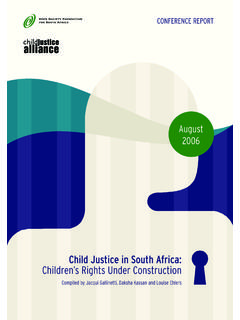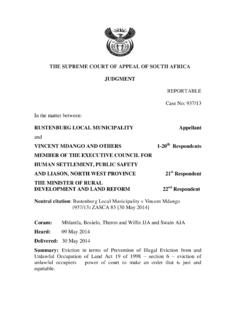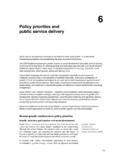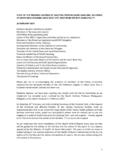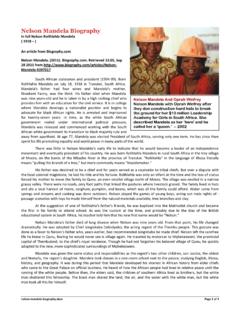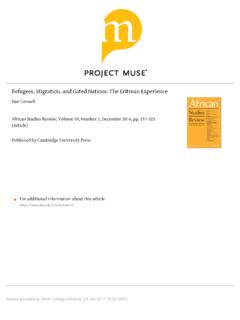Transcription of Construction in Developing Countries: Current imperatives ...
1 Construction in Developing countries : Current imperatives and potentialGeorge OforiNational University of theme: Intelligent Built Environment for LifeWhat does it mean for Developing countries ?2 Intelligent building we should not be left behind. Intelligence how we can use it to enhance capability, capacity. Intelligence how we can use it to leapfrog. Building for life importance of quality, durability, longevity. Building for life quality of life, social of state of knowledge on Construction industries in Developing : to explore new ways to develop the industries. Objectives consider needs for built items in Developing countries in context of national development examine challenges, problems facing Construction industries which must fulfil these needs consider usual solutions proposed explore possible new, contextually relevant ways to develop industries and improve their performance consider how Construction in Developing countries can leapfrog developmental stages; and draw lessons for industrialisedcountries.
2 IntroductionSubject here: to consider contribution Construction industry can make to effort to find viable solutions to development challenges of Developing countries . Studies since mid-1960s. Early works: University College Economics Research Group (UCERG). Ofori (1993, 2012a) reviews development of knowledge on subject. 5 Global agenda for Construction To ResearchersAs a community of researchers, we recognisewe should: develop greater understanding of relationship between Construction and development. For example, we should establish most effective ways built environment sector can contribute to poverty reduction and realisationof other societal objectives adopt a broader perspective to our research, and adopt a multi-disciplinary approach, embracing also, social development move forward our work on sustainable development as it relates activities of built environment sector, to propose practical solutions to issues of energy management, resource conservation, limiting pollution.
3 And establish common meanings ensure we know implications of the same term or expression, in order to foster dialogue among researchers engage industry, and endeavourto make our work relevant to the needs of Built Environment Sector We urge built environment sector and its component parts to identify, prioritisechallenges which it faces, and develop appropriate responses. Sector should: undertake design with respect for, and knowledge of, local history, identity, culture, nature, ecological system, climate and social and national characteristics realisethat research and innovation can be foundations of sustainable competitive advantage communicate its needs and problems to research community forge linkages with academia to ensure more effective application of research agenda for Construction .
4 Development needs, goals and Washington and Post-Washington Consensus programme Various approaches taken to attain long-term development in poorer countries . Washington Consensus in use over 1980s to 1990s comprised (Williamson, 2004): Fiscal discipline Public expenditure priorities moving them away from subsidies and administration Tax reform Financial liberalisation Exchange rates managed to induce growth in non-traditional exports Trade liberalisation Increasing foreign direct investment Privatisation Deregulation Secure intellectual property rights Reduced role for the state. Package intensely debated, criticised(Williamson, 2004). It went through many changes.
5 By late 1990s, it comprised: sound fiscal and monetary policies broad-based taxes at moderate rates market determination of prices and quantities discriminating use of infant industry protection an acceptance of foreign direct investment active government provision of education, health care, and infrastructure anti-poverty programmes. Stiglitz (2004): sharp critique of 1980s and 1990s approaches; concludes that, given differences among countries , there can be no consensus. extreme poverty and universal primary education3. Promote gender equality and empower child mortality5. Improve maternal health6. Combat HIV/AIDS, malaria and other environmental a global partnership for developmentMilleniumDevelopment Goals8 MDGs provided framework for socio-economic development from 2000 to 2015.
6 9 Health* Global child mortality rate in 2015 less than half 1990 rate; fell from 90 deaths per 1,000 live births to 43 (from million to 6 million). Between 1990 and 2013 global maternal mortality ratio dropped 45%, from 380 deaths per 100,000 live births to 210. Between 1995 and 2013 tuberculosis prevention, diagnosis, treatment actions saved 37 million lives worldwide. * Between 2000 and 2015 malaria interventions saved million lives. * Since 2000, global responses to HIV have averted 30 million new * Global youth literacy rate (ages 15 24) increased from 83% in 1990 to 91% in 2015. Adult literacy (ages 15 and older) rose from 76% to 86%. Between 1990 and 2015, number of children in primary education rose in all regions; more than doubled in Sub-Saharan to basic social services Access to improved drinking water source became reality for billion people since 1990.
7 Between 1990 and 2012, billion additional people worldwide gained access to improved sanitation and poverty Between 1990 and 2015, number of people living below $ a day in Developing countries fell from billion to 836 million. Proportion of undernourished people individuals unable to obtain enough food regularly to conduct an active and healthy life decreased in Developing regions from in 1990-92 to in 2014-16. Prevalence of stunting among children under 5 fell from 40% in 1990 to 25% globally in 2013. World s gross national income per capita rose from PPP $8,510 in1990 to PPP $13,551 in progress made on (World Bank, 2016)Progress in connectivity is impressive: by 2015, 95% of world s population was covered by a mobile-cellular signal mobile-cellular subscriptions grew tenfold over 15 years, from 738 million in 2000 to 7 billion in 2015 internet penetration grew from 6% of world s population in 2000 to 43% in 2015 billion people were linked to a global network of content and applications.
8 (UNDP, 2015)12 #q=slums+images880 million in 201513(World Bank, 2016) Post-2015 Development Agenda Post-2015 Development Agenda built around attainment of Sustainable Development Goals (SDGs) (United Nations, 2015b). SDGs are (United Nations, 2015b).. integrated, indivisible, global universally applicable, taking into account different national realities, capacities, levels of development, respecting national policies, priorities. Unlike previous consensus approach, recognisedthat each government: would set its national targets guided by global level of ambition but taking into account national circumstances would decide how targets should be reflected in planning processes, policies, strategies could use different visions, models, tools, in accordance with their contexts and Development GoalsBasic human and national needs Goal 1.
9 End povertyin all its forms everywhere Goal 2. End hunger, achieve food securityand improved nutrition and promote sustainable agriculture Goal 3. Ensure healthy lives and promote well-being for allat all ages Goal 4. Ensure inclusive and equitable quality education and promote lifelong learning opportunities for all Goal 5. Achieve gender equality and empower all women and girls Goal 8. Promote sustained, inclusive and sustainable economic growth, full and productive employment and decent work for allSome of our results Goal 6. Ensure availability and sustainable management of water and sanitation for all Goal 7 Ensure access to affordable, reliable, sustainable and modern energy for allWhat we must do Goal 9.
10 Build resilient infrastructure, promote inclusive and sustainable industrialization and foster innovation Goal 11. Make cities and human settlements inclusive, safe, resilient and sustainable16 Sustainable Development Goals ..2 Broad international goals Goal 10. Reduce inequality within and among countries Goal 16. Promote peaceful and inclusive societies for sustainable development, provide access to justice for all and build effective, accountable and inclusive institutions at all levelsA key international wherewithal Goal 17. Strengthen the means of implementation and revitalize the Global Partnership for Sustainable DevelopmentOur inputs and methods Goal 12.
